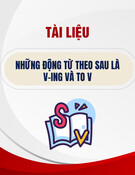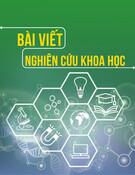
TNU Journal of Science and Technology
229(16): 158 - 163
http://jst.tnu.edu.vn 158 Email: jst@tnu.edu.vn
USING DICTOGLOSS TECHNIQUE TO DEVELOP GRAMMATICAL
COMPETENCE FOR SOPHOMORE ENGLISH MAJORS AT UNIVERSITY OF
EDUCATION - THAI NGUYEN UNIVERSITY
Vu Dinh Bac*, Dang Khanh Linh, Nguyen Thi Kim Chi, Ngo Thi Thanh Hien
TNU - University of Education
ARTICLE INFO
ABSTRACT
Received:
26/5/2024
This study investigates the effectiveness of the Dictogloss technique
in enhancing grammatical competence for sophomore English majors
at Thai Nguyen University of Education. The research aims to address
the pressing need for innovative and effective methods to improve
language learners' grammar proficiency. By employing the Dictogloss
technique, which emphasizes collaborative learning and language
restructuring, the study explores its impact on students' awareness,
attention, and grammatical analysis. The study involves a class
divided into two groups: the experimental group (treated with the
Dictogloss technique) and the control group (using a method other
than Dictogloss). Data collected from questionnaires, tests, and
interviews will undergo rigorous analysis to provide a comprehensive
overview of the Dictogloss technique's effects on grammatical
competence and students' learning experiences. The findings of this
research are expected to be beneficial in the application and
enhancement of grammar proficiency for students at Thai Nguyen
University of Education.
Revised:
06/11/2024
Published:
06/11/2024
KEYWORDS
Grammar
Grammatical competence
Dictogloss
Sophomore
English majors
SỬ DỤNG KỸ THUẬT DICTOGLOSS ĐỂ PHÁT TRIỂN NĂNG LỰC NGỮ PHÁP
CHO SINH VIÊN NĂM 2 CHUYÊN NGÀNH TIẾNG ANH TẠI
TRƯỜNG ĐẠI HỌC SƯ PHẠM - ĐẠI HỌC THÁI NGUYÊN
Vũ Đình Bắc*, Đặng Khánh Linh, Nguyễn Thị Kim Chi, Ngô Thị Thanh Hiền
Trường Đại học Sư phạm - ĐH Thái Nguyên
THÔNG TIN BÀI BÁO
TÓM TẮT
Ngày nhận bài:
26/5/2024
Nghiên cứu này khảo sát hiệu quả của kỹ thuật Dictogloss trong việc
nâng cao năng lực ngữ pháp cho sinh viên năm thứ hai chuyên ngành
Tiếng Anh tại Trường Đại học Sư phạm – Đại học Thái Nguyên.
Nghiên cứu nhằm mục đích giải quyết nhu cầu cấp thiết về các
phương pháp đổi mới và hiệu quả để nâng cao trình độ ngữ pháp của
người học ngôn ngữ. Bằng cách sử dụng kỹ thuật Dictogloss, trong
đó nhấn mạnh đến việc học tập hợp tác và tái cấu trúc ngôn ngữ,
nghiên cứu khám phá tác động của nó đối với nhận thức, sự chú ý và
phân tích ngữ pháp của học sinh. Nghiên cứu bao gồm một lớp được
chia thành hai nhóm: nhóm thử nghiệm (được xử lý bằng kỹ thuật
Dictogloss) và nhóm đối chứng (sử dụng một kỹ thuật khác ngoài
Dictogloss). Dữ liệu được thu thập từ bảng câu hỏi, bài kiểm tra và
phỏng vấn sẽ được phân tích nghiêm ngặt để cung cấp cái nhìn tổng
quan toàn diện về tác động của kỹ thuật Dictogloss đối với năng lực
ngữ pháp và trải nghiệm học tập của học sinh. Kết quả nghiên cứu
này được kỳ vọng sẽ mang lại lợi ích trong việc ứng dụng và nâng
cao năng lực ngữ pháp cho sinh viên Trường Đại học Sư phạm – Đại
học Thái Nguyên.
Ngày hoàn thiện:
06/11/2024
Ngày đăng:
06/11/2024
TỪ KHÓA
Ngữ pháp
Năng lực ngữ pháp
Dictogloss
Sinh viên năm 2
Chuyên ngành tiếng Anh
DOI: https://doi.org/10.34238/tnu-jst.10465
* Corresponding author. Email: bacvd@tnue.edu.vn

TNU Journal of Science and Technology
229(16): 158 - 163
http://jst.tnu.edu.vn 159 Email: jst@tnu.edu.vn
1. Introduction
Teaching English in general requires solid knowledge of the language, teaching methods and
the ability to interact with learners. Thousands of English students in Vietnam are still looking for
an effective way to learn English. While many of them work daily to get better at grammar, they
often struggle to recall and use the rules when speaking English. This research introduces the
Dictogloss technique and also motivates us to conduct a Dictogloss study on English language
teaching for sophomore students at Thai Nguyen University of Education.
Grammar plays a crucial role in English teaching and learning, forming the fundamental
structure of communication. It is essential for learners as it offers insights into arranging words
and sentences to convey meaning. The ultimate goal of teaching English is to enable fluency in
both speaking and writing, emphasizing language communication skills and knowledge mastery.
Grammar awareness serves as a key element in lesson planning and curriculum design, providing
a foundational knowledge base for learners to build upon, facilitating the progression to advanced
vocabulary and grammar structures. Grammar has long been the foundation of English Language
Teaching (ELT) curricula at all levels, including at the university level. In discrepancy, the
advent of communicative language teaching (CLT) in the 1970s led to a tendency not to
emphasize certain grammars in the classroom, although grammar was widely regarded as a
means of communicating fluently in a language. Unfortunately, without grammar, it is difficult to
teach English learners the ability to speak English [1]. The Dictogloss technique has its origins in
the broader field of language teaching and second language acquisition. Attention hypothesis
(Schmidt, 1990) [2]: The concept of "attention" in language learning, proposed by Michael H.
Long and later expanded by Stephen Krashen, suggests that learners need to pay attention
consciously aware of certain features of language before they can acquire and absorb it.
The study on using the Dictogloss technique for developing grammar competence in
sophomore English majors aims to assess its effectiveness in enhancing specific grammatical
knowledge relevant to academic studies. It explores how Dictogloss promotes attention to
grammatical structure and analyzes students' collaborative restructuring of texts. The research
compares Dictogloss with traditional grammar teaching methods, evaluating learning outcomes
and application for English majors. The study tests the long-term retention of grammatical
knowledge acquired through Dictogloss and examines its transferability to new contexts.
Exploring motivation and engagement, it assesses whether Dictogloss enhances students' interest
in learning grammar. Through the use of the Dictogloss technique, English learners will find
effective ways to develop their grammar skills. By engaging in this technique, students can
actively practice grammatical structures, sentence formation, and word order, leading to a better
understanding and application of grammar rules. Moreover, Dictogloss promotes active learning
by requiring students to listen attentively, analyze the text, and collaboratively reconstruct it. This
hands-on approach encourages student engagement, critical thinking, and problem-solving skills.
1.1. Grammatical competence
Grammatical competence is the ability of learners to acquire knowledge of a language's
grammar with confidence and apply this knowledge with ease to communicate in a given context.
It includes the ability to gain knowledge of new words, forms, syntax, semantics, etc., and is
operated as part of communicative competence. There is no denying the role of grammar, through
which communication becomes clear and understandable. No one can claim to have attained
grammatical capability in their mama lingo unless they've learned it duly and know all the rules.
1.2. Background on Dictogloss
Digtogloss was created by Wajnryb in 1990 [3] to focus on grammar. It is a teaching
technique that involves the reconstruction of a text by learners based on a dictated version

TNU Journal of Science and Technology
229(16): 158 - 163
http://jst.tnu.edu.vn 160 Email: jst@tnu.edu.vn
provided by the teacher. The students listen to a short passage read at a normal level and then
reconstruct and reinterpret the text. According to Wajnryb (1990), the main task is not only
learning in the environment but also interacting with the student. When implementing the
Dictogloss technique, it is easy for teachers to adapt the stages of the Dictogloss task in a
creative, logical way to suit the needs of the students. Wajnryb (1990) stated that: “Dictogloss is
a technique in language instruction that takes a small step after dictation that forces students to
reconstruct a spelled text, capturing as much as possible”. The content of the information is
absolutely correct and exists in an acceptable form of language.
Small (2003) defines [4]: “Dictogloss as an operation in which short passages of language are
read at medium speed”. Similarly, Cross (2002) defines [5]: “Dictogloss as grammatical dictation
or can be thought of as a method of communication based on the teaching task”. Swain and
Lapkin (1998) [6] how that Dictogloss is effective in helping students acquire knowledge of
language by making them aware of the form and function of language.
1.3. The advantages and disadvantages of using Dictogloss
Vasiljevic (2010) pointed [7] out that Dictogloss has the followed advantages:
Firstly, the Dictogloss technique is an effective method of combining individual and group
activities. Students listen and record individually and then put the text back together.
Secondly, as noted by Karen (2012) Dictogloss facilitates improving communication capacity
for learners.
Thirdly, the reconstruction phase helps students test hypotheses and identifies strengths and
weaknesses. Mackenzie (2011) states that the Dictogloss process uses the principles of language
comprehension through two domains: efficiency and cognition. Positive group interactions and
interdependence can have an impact on students' motivation towards working together to achieve
something in common.
Finally, Dictogloss offers a dynamic and varied instructional approach, breaking away from
traditional teaching methods and providing a refreshing change for learners. Dictogloss also can
incorporate authentic texts that reflect cultural nuances, helping learners gain insights into
language use within specific cultural contexts.
Besides that, Dictogloss will not be considered effective for low-level learners. Issues
introduced into the lesson or provided by the teacher may not match the needs or interests of the
students because teachers often pay attention to the form, not the subject.
Plus, Small (2003) argued that superior learners may prevent others from fully participating,
especially during periods when they tend to dominate opportunities for reconstruction
completion. tasks rather than sharing them with other learners.
Vasiljevic (2010) suggests that learners unfamiliar with this teaching-learning method may
want to write down each dictation word. Teachers need to give students more training to get them
used to Dictogloss because it takes more time to plan and apply dictionary technique.
2. Methodology
The study applies Krashen's input hypothesis and Schmidt's attention hypothesis to
demonstrate the effectiveness of Dictogloss in improving grammatical competence. The research
sample consisted of 30 second - year students (English class K57B), who were divided into two
groups: an experimental group comprising 15 students utilizing Dictogloss and a control group
consisting of 15 students who did not employ Dictogloss. To assess the student's current grammar
level, a comprehensive grammar level test will be administered. This test aims to identify
individual strengths and weaknesses, providing a basis for assessing progress throughout the
study. During weeks 2 to 7 of the semester, the Dictogloss technique was systematically
integrated. In week 8, students underwent a paper-based test reflecting the structure of the
formative assessment. This post-implementation assessment aimed to quantify student progress

TNU Journal of Science and Technology
229(16): 158 - 163
http://jst.tnu.edu.vn 161 Email: jst@tnu.edu.vn
after consistent application of the Dictogloss technique. The researcher meticulously designed a
comprehensive questionnaire including 05 closed questions and 05 open questions. Once
completed, the questionnaire link was disseminated to the student group, with clear instructions
to ensure a high response rate. To better understand the student experience, approximately 05
participants were selected for in-depth interviews. These interviews delved into each individual's
feelings, attitudes, and perceptions about the Dictogloss technique. The data collected from
questionnaires, tests, and interviews were subjected to rigorous analysis, offering a
comprehensive overview of the impact of the Dictogloss technique on students' grammatical
competence and their learning experience. A comparative analysis was conducted between the
experimental group (using Dictogloss) and the control group (not using Dictogloss) to identify
any significant differences in grammar proficiency. Students' scores after taking the test showed
how effective the Dictogloss technique was in improving grammar ability. By combining both
qualitative and quantitative data collection methods, this research aimed to provide a
comprehensive evaluation of the Dictogloss technique in developing grammatical competence
among sophomore English majors.
3. Findings and discussions
As shown in table 1 and figure 1 for the control group, the results of the pre-test indicate
relatively low scores. Scores of 5-6-7 constitute a significant portion, while excellent scores of 8-
9-10 are only achieved by 3 students. Overall, the grammatical competence of language majors is
relatively low. Furthermore, the average score of the pre-test is 6.68, higher than that of the
experimental group by 0.24 points. After 6 weeks of grammar structure review, there is a
difference observed in the experimental group, the average score of the post-test is higher than
that of the control group by 0.95 points. On the other hand, the control group shows no
significant improvement, with a slight increase of 0.08 points from 6.68 in the pre-test to the
post-test.
Table 1. The result of students’ score in two tests (pre-test and post test) in the control group
No
Pre-test score
Post-test score
1
6
6.3
2
7.3
7
3
6.6
6.3
4
6
7
5
6.6
6.3
6
8
7.6
7
8.6
9
8
Absent
8
9
7.3
7.3
10
7.3
7
11
8
8
12
5.3
6
13
4
5.3
14
6
6.3
15
5.3
5.3
Total
103.3
94.7
Average
6.68
6.76
As shown in table 2 and figure 1 for the experimental group, the lowest score in the pre-test
was 4, while the lowest score in the post-test was 5.3. In the second test, the average score of the
post-test is 7.71, higher than the pre-test by 1.27. This indicates a gradual improvement in
students' grammatical proficiency. Throughout the process, students demonstrated significant
progress from the beginning to the end of the cycle. They gradually mastered grammar rules
based on context. The Dictogloss technique has proven to be highly effective in enhancing

TNU Journal of Science and Technology
229(16): 158 - 163
http://jst.tnu.edu.vn 162 Email: jst@tnu.edu.vn
students' grammatical competence. Scores at the weak and average levels tended to decrease,
while scores at the good and excellent levels increased significantly.
Table 2. The result of students’ score in two tests (pre-test and post test) in the experimental group
No
Pre-test score
Post-test score
1
7.3
Absent
2
5.3
7
3
8
9
4
6.4
8.3
5
4.7
6.3
6
6
8
7
8.6
9.3
8
4
5.3
9
6.6
7.6
10
4
6
11
7.3
8
12
7.3
8.3
13
7.3
8.3
14
7.3
9
15
6.6
7.6
Total
96.7
108
Average
6.44
7.71
Figure 1. The result of students’ score in 2 tests
Table 3. Evaluation table of improvement in English ability in general and grammar in particular when
applying the Digtogloss method for the experimental group according to the Likert scale
Statements:
The Digtogloss method helps me:
Levels of agreement:
Unit: Students
1
2
3
4
5
1. Improve my grammatical competence as a sophomore English major
0
1
3
9
2
2. Using correct grammatical structures in English
0
0
2
8
5
3. Enhance my ability to accurately apply grammar rules in my writing skills.
0
1
4
7
3
4. Know how to write correct sentences
0
2
5
6
2
5. Develop my listening skills
0
0
2
6
7
6. Avoid common grammar mistakes
0
1
2
4
8
7. Become more interested in learning English
0
2
3
5
5
8. Remember long words and sentences faster
0
1
2
4
8
9. Have a deeper understanding of difficult grammar structure
1
0
4
8
2
10.Learn more new words
0
0
1
5
9
1 - Strongly Disagree; 2 – Disagree; 3 – Neutral; 4 – Agree; 5 – Strongly Agree
6.68
6.44
6.76
7.71
5.5
6
6.5
7
7.5
8
Control Group Experimental Group
Pre-test Post-test












![Bài tập thì hiện tại hoàn thành [kèm đáp án chi tiết]](https://cdn.tailieu.vn/images/document/thumbnail/2025/20251106/thuthao27062004/135x160/41601762420911.jpg)






![Tài liệu ôn tập Ngữ pháp tiếng Anh [chuẩn/mới nhất/tổng hợp]](https://cdn.tailieu.vn/images/document/thumbnail/2025/20250821/vuongdinhlinh1412@gmail.com/135x160/933_tai-lieu-on-tap-ngu-phap-tieng-anh.jpg)




